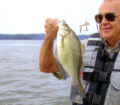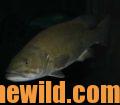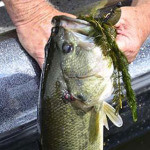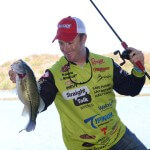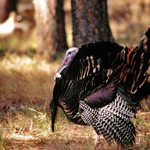 Editor’s Note: Even a dog knows to get out of the sun when the temperature is 90+ degrees, and many bass anglers across the nation have discovered that bassing is more productive after dark on most rivers and lakes in the summertime.
Editor’s Note: Even a dog knows to get out of the sun when the temperature is 90+ degrees, and many bass anglers across the nation have discovered that bassing is more productive after dark on most rivers and lakes in the summertime.
Bernie Spidle of McCalla, Alabama, fishes rivers, particularly the Warrior River in central Alabama, on hot summer nights. “I was a member of the Birmingham Bassmasters, a club that began to hold nighttime tournaments in the 1980s,” Spidle recalls. “So, I pre-fished for those summertime night tournaments and caught a lot of bass at night – actually more fish after dark, than during the daylight hours in hit weather. Then I got hooked by the night-fishing bug and still today consistently catch more and bigger spotted and largemouth bass and enjoy bass fishing in the summertime more when I fish at night.”
When I fished in 95-degree weather at the river with Spidle, he explained, “I generally start fishing an hour before dark, but the best bassing often is from 11:00 pm until 2:00 am. After the river has calmed and quieted down, the bass don’t seem as reluctant to move up higher in the water. I like to fish points and rock walls on the river at night in the hottest weather. On a good evening, I may catch five to 10 bass off a point, but most of the bass I catch come from the sheer rock walls and bluff walls out here on the main river. This point that we’re fishing runs several hundred yards out into the river, and it’s a sheer rock bluff. The top of the bluff will be from 12 to 20 feet deep. Then it drops off to about 45-feet deep on either side of the point. I like to 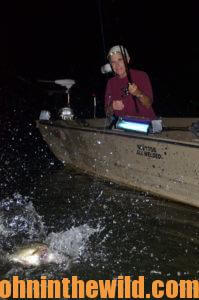 try and fish right on the edge of the drop-off, because the bass will come out of the deep water late in the afternoon and at night and feed on shad on top of the point.
try and fish right on the edge of the drop-off, because the bass will come out of the deep water late in the afternoon and at night and feed on shad on top of the point.
“I catch bass here on deep-diving crankbaits, jigs, worms and plastic lizards. One of my favorite baits to fish is a shaky head worm. I’ll use 50-pound-test braided line and tie a 10-pound fluorocarbon leader onto the end with an Albright knot. By using the braided and the fluorocarbon lines together, I’ve found that I drastically increase the sensitivity of my line, and I can feel a bite much better. The braid also adds power to the line.”
Night fishing for bass hasn’t changed much in the last 20 to 40 years. Most anglers fish with fluorescent line that seems to glow when it comes in contact with the black lights mounted on the sides of many anglers’ boats. “In the early days of nighttime bass fishing, we used black lights and fluorescent Gold Stren line and fished with black-plastic lizards and black-and-blue jigs,” Spidle recalls. “We also would slow-roll big spinner baits with thumping single Colorado blade. Although I fish several baits at night, the black-plastic lizards have proved to be the lure that consistently gets largemouths at the Warrior River.”
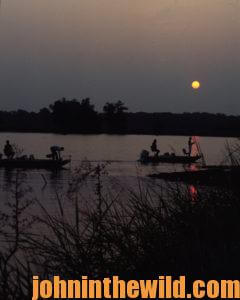 You may think that the obvious place to fish for bass at night is in the grass, however, after fishing with Spidle, I’ve learned that the grass is not where you catch the most bass at night in the river he fishes. “The grass receives a lot of bass-fishing pressure,” Spidle explains. “I believe that the bigger bass hunt crawfish at night. That’s why I fish rocky points and rock ledges instead of the grass. Also, often the grass is in much-more shallow water than the rock points and sheer rock bluffs are. When the water becomes as hot as it does in August and the first part of September, the bass prefer to stay in the deeper water, closer to the cooler, very-deep water.
You may think that the obvious place to fish for bass at night is in the grass, however, after fishing with Spidle, I’ve learned that the grass is not where you catch the most bass at night in the river he fishes. “The grass receives a lot of bass-fishing pressure,” Spidle explains. “I believe that the bigger bass hunt crawfish at night. That’s why I fish rocky points and rock ledges instead of the grass. Also, often the grass is in much-more shallow water than the rock points and sheer rock bluffs are. When the water becomes as hot as it does in August and the first part of September, the bass prefer to stay in the deeper water, closer to the cooler, very-deep water.
“This point we fished tonight at the Warrior dropped off from 12 to 20 feet down to 45 feet. A bass could come out of the 45-foot deep water, move into the 12 to 20 foot water, which was still cool, feed and then return to the deep water again. That 12 to 20 foot water wasn’t nearly as warm as the 5 to 6 foot water or even the more-shallow water where you’d find the grass. Many of my best night-fishing spots rarely produce good bass fishing in the daytime in hot weather.”
When you look at a sheer rock bluff and don’t see any cover along that bluff and seemingly no place for bass to ambush bait, you’ll think there’s no reason to fish those bluffs. However, Spidle has discovered that the bass generally will feed along the bottom in that first 10 feet from where the bluff comes in contact with the bottom. “Probably 80 percent of my strikes occur when my bait first hits the bottom of a sheer rock bluff and moves about 10 feet out from the bluff,” Spidle reports. “My two favorite baits for fishing these bluffs are the 6-inch Zoom (https://zoombait.com/6-inch-lizard/) lizard or a black jig with a trailer. However, on some nights, the bass just won’t take those baits. Then I start fishing the shaky head worm. Generally, the jig will catch my biggest bass, and the black lizard will catch the most bass. But when those two baits aren’t working, I’ll put on a 1/8-ounce shaky head jig, with a solid-black 6-inch plastic worm to catch nighttime bass. To increase the size of nighttime bass I catch on the shaky head, I’ll often use a trick worm.”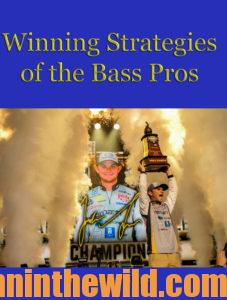
To learn more about bass fishing, check out John E. Phillips’ book, “Winning Strategies of the Bass Pros” at https://amzn.to/2XJrz3k available in Kindle, print and Audible versions.
Tomorrow: Smallmouths on Lakes at Night in Hot Weather

